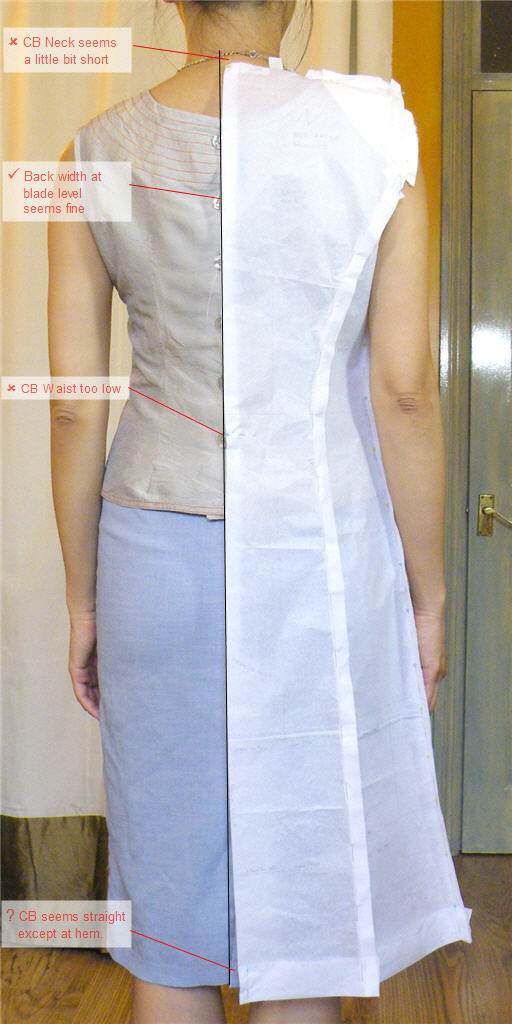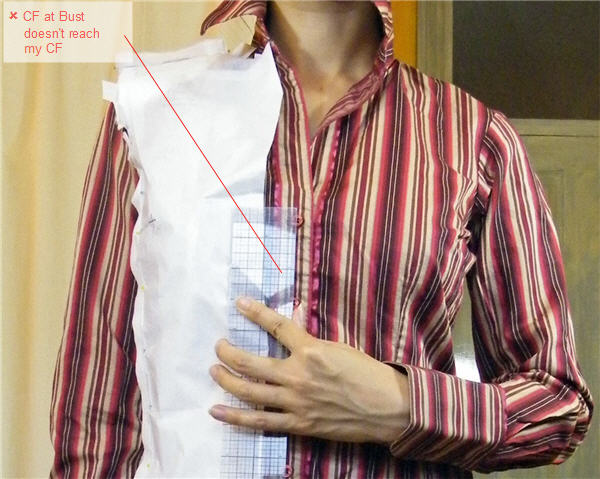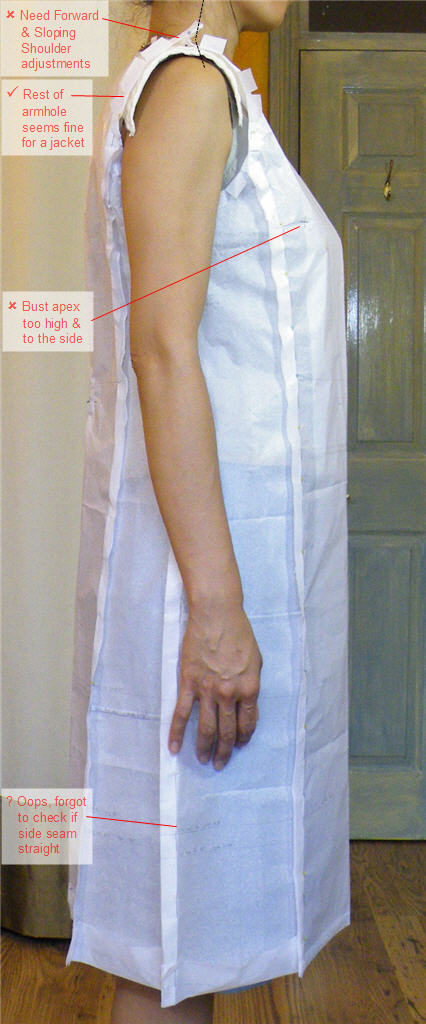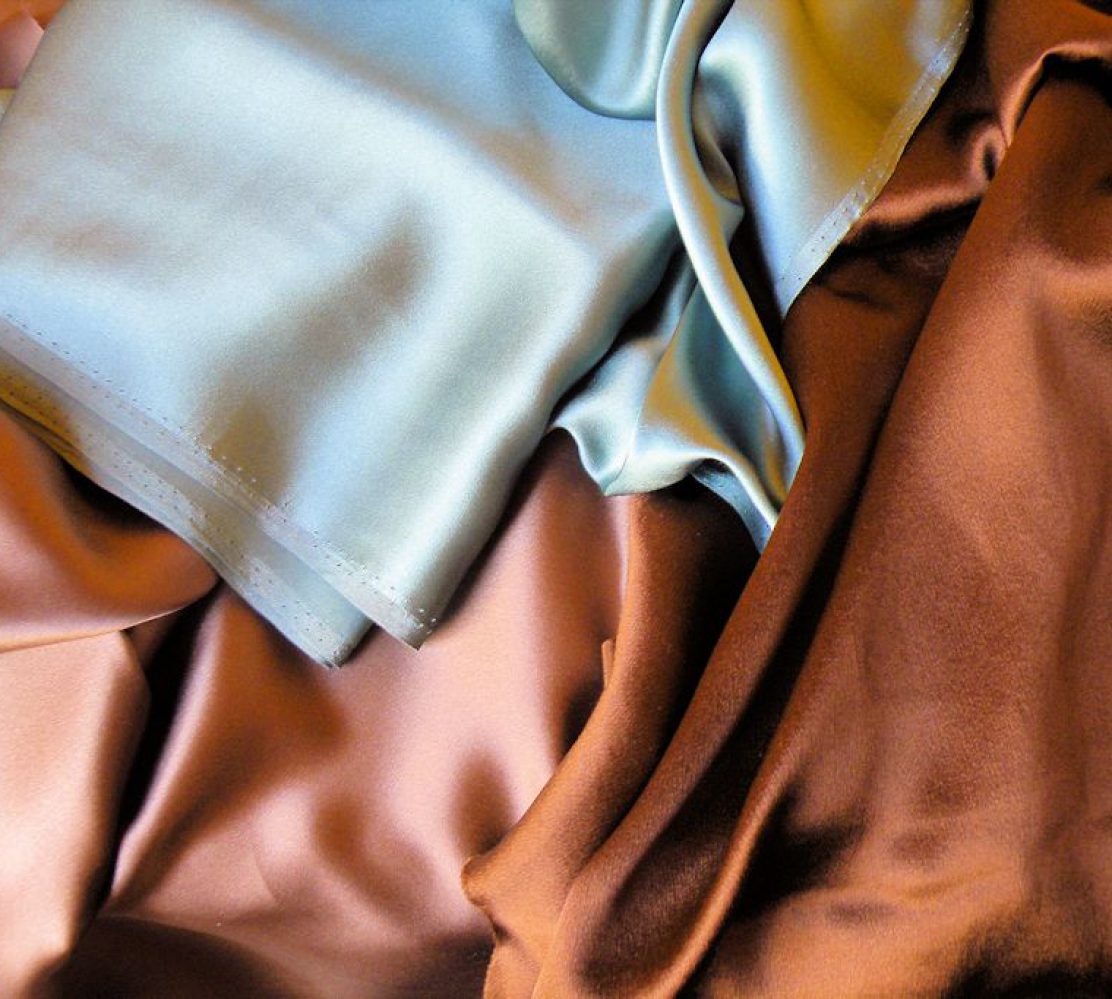OK, let’s get serious now. Let’s talk about fitting. And let’s get one thing straight: I hate making Muslin muslins. You know, the type that goes to the landfill afterward. I know it’s sometimes unavoidable. But what’s left of my green conscious won’t allow it for every single garment.
So I’m giving Palmer / Pletsch’s Fit For Real People tissue fitting + fit as you sew technique a proper go. If I can make it work – learn to read the tissues, learn to mentally prepare for fabrics behaving differently – then at least I’ll end up with wearable muslins.
A word of warning before I get started. This is like the 2nd time I’ve tried this technique. So I’m no expert. I’m just sharing my experience so we can learn together. And if you’re already expert at this, please share your wisdom!
Tissue Fitting #1: unaltered bodice
As instructed I pinned the tissue pieces together without any alteration and check the back width first.
I’m using size 8, which is officially two sizes too small for my current measurement. But I was once size 8, and I’m working with the hypothesis that I’d get better results using this with FBA & other girth adjustments where needed.

- Size 8 back seems wide enough.
- CB seems surprisingly straight. I normally get bunching at lower back / waist, so I was expecting CB to be too long so swinging to the side at the bottom. There is a slight swinging, but not as much as I’d expect.
- CB waist is too low though.
- CB neck is also lower than base of my neck. But I’m not sure if I should alter this. How do you tell if the neckline is meant to be lower? Some McCall / Vogue patterns indicate lowered back neckline on the back pattern. This one doesn’t. But at least a couple of pattern-making books I have mention lowering the back neckline slightly for jackets & coats.

As the back width is wide enough, I’m OK to check the front width.
- Finished bust is suppose to be 36″, which would already give me a 2″ ease. But CF at bust doesn’t come to my CF without pulling & creating drag lines. I measure about 1″ difference. Also, as this will be worn over other clothing, I reckon I’d need more bust ease anyway. This trench is suppose to be semi-fitted, which supposedly should have 3-5″ ease. I’ll aim for 4″ & maybe sew a wider SA if it seems too loose at fabric fitting stage.
 Armhole seems a little bit big at the shoulder seam & also to far to the back. From previous sloper fitting attempts I know I have slopping shoulders & forward shoulder (too much computer work). So definitely need adjustments here. Rest of the armhole looks OK to me considering that this is a jacket – ie need bigger armhole to fit over other garments.
Armhole seems a little bit big at the shoulder seam & also to far to the back. From previous sloper fitting attempts I know I have slopping shoulders & forward shoulder (too much computer work). So definitely need adjustments here. Rest of the armhole looks OK to me considering that this is a jacket – ie need bigger armhole to fit over other garments.- From the side you can see the bust point is too high up and too much to the side.
- Forgot to check if the side seam is straight. Oops.
First alterations I’m going to make:
- Rounded upper back adjustment
- Sloping & Forward Shoulder adjustments
Results tomorrow!


Really enjoying this blog as I have opted for this approach too (at least at present). Still have a bit of doubt about it – I yearn for that uber fit that couture has, and they definitely use muslins, muslins and muslins. I have that book as well and also one of their walk-you-through patterns (I’ve finally faced up to the fact that I need to make an FBA). But I was rather discouraged when I made up a 10 in Swedish tracing paper and the armhole was too small. Quite a surprise. The southern hemisphere winter has dampened my enthusiasm for fittings at present so I’ve rather lost my mojo (a weak excuse I know, it’s not that cold). Your blog is inspiring me to get my *#^* back into gear. Yeah, the book’s designs are pretty dated, but the fitting of some pretty difficult shapes is enlightening and I like their down to earth style. Back to your trench – on the face of it, it looks you should get a decent fit with these relatively minor alterations, so looking forward to seeing how it goes.
Have you seen this mythical beast the uber fit couture outfit in person? I also have some doubts about the FFRP approach. But equally I have doubts about the so-called ‘couture’ approach as well. I guess I’m just a skeptical person by nature! But skeptical with an open mind.
I read on Fashion Incubator that muslin is not ideal for checking fit, because most of the time it doesn’t behave the same way as the fashion fabric.
Checking my old edition of Couture Sewing Techniques by Claire Shaeffer (p37), it seems like the haute couture houses uses muslin more for developing the pattern on customized dress form, but then after that fittings are done in the fashion fabric.
Either way it’s always going to be difficult to fit oneself. Neither couture nor RTW have that problem do they? Lucky bastards!
Ultimately it comes down to what works for you with your unique shape & sewing situation (eg whether you have a helper or not, a faithful dress form or not). For me, cutting amount of unwearable fitting muslins is a priority. So FFRP would be great if it works!
Well, this is thorough! I just finished reading the FFRP book and was surprised about the how thorough their tissue fitting method was. This is looking good. I love all your alteration documentation! Keep posting, pls! 🙂
I found that book a fun read even if you don’t end up using the techniques. Fascinating tidbits and stories. The garments aren’t the most inspiring examples. But the fact that they got different sizes to fit to real people was inspiring.
This seems like a very good approach! I have FFRP and haven’t really ever taken the care/time to be this thorough with a paper pattern.
We’ll see how long it last! LOL.
When I tried with the sloper I got the run-around and eventually gave up / parked it. Hopefully tissue fitting these looser fitting garments will be less torturous. Tight rope & all that!
I’m really impressed with the thorough work you’re doing! I must try that method some time and not only use my “not so much humanly looking dress form” which gives results that are so and so from time to time.
Isn’t it funny the fact that the more you sew the more advanced fitting techniques you need as you get to know your own body’s quirks, like in my case is a sway back and one shoulder that is slightly lower than the other, facts I was happily unaware of before I started sewing. You’d think it would get easier after sewing for a while… 🙂
And how do you do with the photo-taking? Do you have some kind of remote to trigger the camera or do you get help to from someone? I mean, standing straight up in front of the mirror with a camera in one hand is not the easiest thing to do.
Indeed, it does get more challenging as your awareness & ambition increase! Ignorance is bliss and all that I suppose.
Photo-taking…I use a tripod and the timer setting on my camera. I wish I could use a remote, as the timer function has to be reset after every single shot. What pain! But this camera doesn’t support remotes.
I also put a long mirror behind the camera to help me see what I’m doing. Sometimes I can even see what’s in the viewfinder LCD screen reflected in the mirror – useful for checking that I’m not too off to one side or too close or near.
Nowadays I also use two task lights with big ass photography bulbs. My sewing room is north-facing, so I don’t get enough sun light and the photos get too blurry without extra lights.
I might try this. I’ve had fits finding proper pattern sizes. The patterns seems w-a-y too big when I use the actual measurements, but I go ahead and muslin them anyway…and have been universally disappointed. Aaargh!
When I use the “correct” size by bust or hip measurement, the crotch is too low, the neck too wide and loose. Like you said, it may be best to try a smaller size and enlarge the appropriate parts.
I’m almost to the point of trying to draft my own patterns, but I love the sales at McCalls and Vogue too much!
FFRP would have you believe you can start with any size, but it’s a question of which size will require the least tinkering. If you’re working with the Big 4, maybe trying out their fitting pattern in a couple of sizes might help you figure which would be the quickest to alter. Neighborhood sewing workshops should really do what P/P do and have gingham muslin of these in all the sizes so students / customers can try them on to figure out the best sizing.
But there’s still the question of how much wearing & design ease the pattern companies are adding. And why are they not updating the design ease at least to reflect current RTW fit.
As for M/V sales, I’m actually struggling to find patterns that I’d like to buy. Vogue is great with the designer range. But in general I get a sense of deja vu. The patterns all look so similar. Where as in London at least, some of the high street brands offer more interesting design details that I rarely find in commercial patterns & pattern magazines. So I’m slightly more inclined to draft my own patterns in the future…Once I master that perfectly fitting sloper of course!